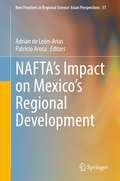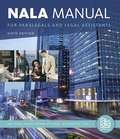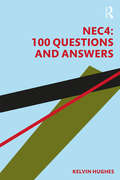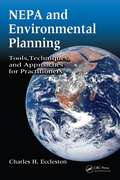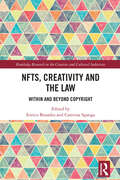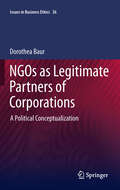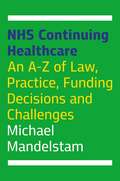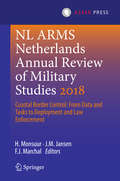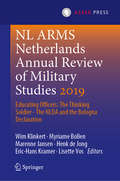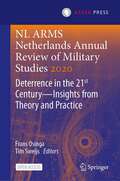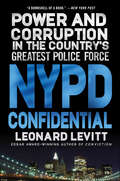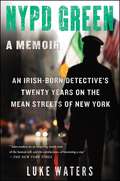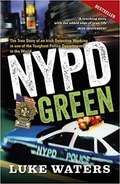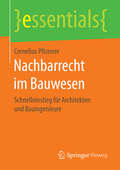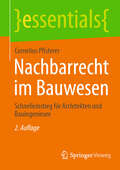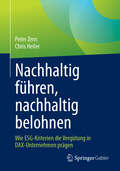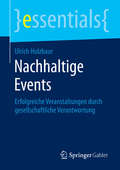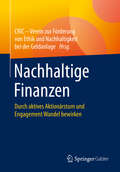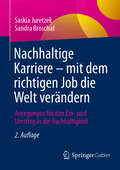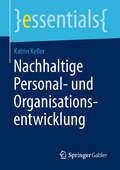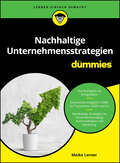- Table View
- List View
NAFTA’s Impact on Mexico’s Regional Development (New Frontiers in Regional Science: Asian Perspectives #51)
by Patricio Aroca Adrián de León-AriasIn this book, the dynamics of continuity and change in the regional economic development of Mexico and the US border states are analyzed. These studies cover the last 25 years, after the first trade agreement, between a developed and a developing country, tooks place, and where international trade and investment have been combined with a set of relevant local factors such as regional innovation, industrialization patterns, multinational corporations’ modes of operation, public investment, and national content of exports. The book offers researchers a precise identification of stylized facts that characterize the pattern of regional development in Mexico and the US Southwest as well as state-of-the-art applications contrasting hypotheses from new economic geography, endogenous and neo-Schumpeterian economic growth models, and new international trade. To graduate and advanced undergraduate students in the fields of spatial geographic economics, this book offers an excellent source for its updated review of current topics on regional development in Mexico. To policy makers, the book helps to identify policy areas to reinforce the dynamics of regional development. Whereas other books have looked at the several impacts of NAFTA on national economies, productive sectors, and societies, this book analyzes the trade agreement’s impact with a long-term view across the diversity of developments of Mexico´s regions. As well, the analysis is carried out with the perspective of prospective reforms of a renovated trade agreement between the United States and the new Mexican federal administration . The collaborators in this book are researchers who are experts at the international and national levels in the field of regional economic development. During the last 25 years they have conducted their analyses in different regions of Mexico and the United States as university researchers, advisors to state and federal governments, and as practitioners.
NALA Manual For Paralegals And Legal Assistants: A General Skills And Litigation Guide For Today's Professionals
by Inc. National Association of Legal AssistantsSucceed on the job--and in your course--and prepare for the Certified Paralegal examination with the NALA Manual. More than 100 leading authorities with a wide range of experience in legal disciplines and management have contributed to this comprehensive manual since it was introduced in 1976. Covering all the skills required of paralegals today, the updated manual includes a collection of successful solutions to actual assignments accomplished by working paralegals nationwide. These proven techniques and procedures can be used as starting points from which you can make changes, adaptations, and modifications when you encounter similar situations on the job.
NEC4: 100 Questions and Answers
by Kelvin HughesThis book details some of the most important and interesting questions raised about the NEC4 family of contracts and provides clear, comprehensive answers to those questions. Written by an NEC expert with over 20 years’ experience using, advising and training others, the book has several distinctive features: It covers the whole NEC4 family It is written by a very experienced NEC author who explains sometimes complex issues in a simple and accessible style The questions and answers range from beginner level up to a masterclass level The questions are real life questions asked by actual NEC practitioners on real projects. The book includes questions and answers relating to tendering, early warnings, programme issues, quality management, payment provisions, compensation events, liabilities, insurances, adjudication, termination and much more. It is essential reading for anyone working with the NEC4 family of contracts, whether professionals or students in construction, architecture, project management and engineering.
NEPA and Environmental Planning: Tools, Techniques, and Approaches for Practitioners
by Charles H. EcclestonA tool for predicting environmental impacts, the National Environmental Policy Act (NEPA) can also be used to predict the impacts of natural disasters and potential terrorist attacks. This book demonstrates how to use NEPA as a framework to support decision-making. It includes examples that demonstrate how NEPA can be efficiently integrated with other processes such as ISO 14001, P2, and Adaptive Management. It provides proven tools, techniques, and approaches for streamlining NEPA and environmental planning strategies that reduce the potential for controversy and criticism. It is the first text that covers recent changes to NEPA and the new CEQ guidance expected to be issued.
NFTs, Creativity and the Law: Within and Beyond Copyright (Routledge Research in the Creative and Cultural Industries)
by Enrico Bonadio Caterina SgangaNon-Fungible Tokens (NFTs) have emerged as an important medium for the creation, sale and collection of art, with many major business and fashion houses creating their own NFT projects. This book investigates the eruption of NFT crypto art, and its impact on copyright law.Chapters address topics at the intersection between AI, smart contracts, data science, copyright law and arts administration. With snapshots of the ongoing heated debates around copyright law, the book investigates whether NFTs violate copyright and moral rights, the liability of NFTs platforms, impacts on ethical issues such as counterfeiting. The first book published on this emergent topic, this book offers a comprehensive overview of opportunities and challenges raised by NFTs to copyright law and, more generally, to the regulation and economics of the creative and cultural industries.The book is addressed to law and tech enthusiasts as well as academics, students, practitioners and policy makers interested in the intersection between copyright rules and new forms of technology.
NGOs as Legitimate Partners of Corporations
by Dorothea BaurThe interaction between corporations and non-governmental organizations (NGOs) has become an important topic in the debate about corporate social responsibility (CSR). Yet, unlike the vast majority of academic work on this topic, this book explicitly focuses on clarifying the role of NGOs, not of corporations, in this context. Based on the notion of NGOs as political actors it argues that NGOs suffer from a multiple legitimacy deficit: they are representatives of civil society without being elected; the legitimacy of the claims they raise is often controversial; and there are often doubts regarding the legitimacy of the behaviour they exhibit in putting forward their claims. Set against an extended sphere of political action in the postnational constellation this book argues that the political model of deliberative democracy provides a meaningful conceptualization of NGOs as legitimate partners of corporations and it develops a conceptual framework that specifically allows distinguishing legitimate partner NGOs from two related actor types with whom they share certain characteristics but who differ with respect to their legitimacy. These related actor types are interest groups on the one hand and activists on the other hand. In conclusion it argues that a focus on the behaviour of NGOs is most meaningful for distinguishing them from interest groups and activists.
NHS Continuing Healthcare: An A-Z of Law, Practice, Funding Decisions and Challenges
by Michael MandelstamThis authoritative guide to the law of continuing healthcare provides clarity on a contentious issue for those in long-term care: which adults are eligible for full NHS funding, as opposed to self-funded social care.Written by seasoned legal expert Michael Mandelstam, it provides practitioners with clear information on both the letter and spirit of the law, written in an accessible style suitable for a wide range of health and social care practitioners. The book gives all the need-to-knows in a handy A-Z format for quick reference, including key legal rules, guidance and case law.It contains also an extended analysis, with detailed evidence, of NHS continuing healthcare over the last 30 years up to the present. This is critical in order to understand why the rules are so complex, confusing and sometimes disregarded, and why decisions can seem counter-intuitive, unfair and difficult to challenge.The book is essential reading to assist the making of decisions that are fair, lawful and transparent.
NL ARMS Netherlands Annual Review of Military Studies 2018: Coastal Border Control: From Data and Tasks to Deployment and Law Enforcement (NL ARMS)
by H. Monsuur J. M. Jansen F. J. MarchalThis book provides a comprehensive study of border control: from data analysis andinformation warfare, frameworks for command and control, and game-theoretic riskmanagement, up to the (optimal) deployment of law enforcement missions.Innovative about this book is that it approaches the subject from several angles, aimingto connect theory and practice of law enforcement missions with risk management and/or quantitative modelling. Some chapters focus on legal challenges and informationwarfare, while others provide quantitative modelling of military asset deployment inthe area of interest, or show the benefits of cooperative wireless sensor networks forborder control. A case study of the Dutch Border Security Team supplements the theory.The publication is ideally suited for reference use by students, academicians, researchersand professionals in the field of border control and related areas.H. Monsuur is Professor of Military Operations Research, J.M. Jansen is AssociateProfessor of Operational ICT, and F.J. Marchal is Lecturer of International/MilitaryLaw at the Faculty of Military Sciences of the Netherlands Defence Academy in DenHelder, The Netherlands.
NL ARMS Netherlands Annual Review of Military Studies 2019: Educating Officers: The Thinking Soldier - The NLDA and the Bologna Declaration (NL ARMS)
by Wim Klinkert Myriame Bollen Marenne Jansen Henk De Jong Eric-Hans Kramer Lisette VosThis book has as its subject matter the academic education of officers and builds on the signing of the Bologna Declaration in 1999 by twenty-nine European ministers for Education and Science, who thereby agreed to coordinate higher education across Europe, by, for instance, the implementation of the Bachelor's and Master's system. In the meantime, military academies have also introduced the BaMa system into their programs for officers’ education, which marks a transition from the old days, when officers’ education took place within a national military system, under military command, and was firmly grounded in principles, traditions and needs, as professed by the Ministries of Defence and the armed forces in particular. So the Bologna Declaration can be seen as crucial leverage for the development of in-house academic degree programs as a fundamental part of officers’ education. With this volume, the editors of NL ARMS 2019 strive to offer a platform to both academics and military and civilian practitioners, as well as to combinations of these, to reflect and share their thoughts on officers’ education `before and after' Bologna, both in The Netherlands and abroad. To this end, controversies and challenges, affecting various aspects and systems of officers’ education, have been grouped into five themes. Respectively, the first four themes comprise institutional settings and change; educational philosophy; educational challenges and reflective practices; and didactical solutions. The fifth theme, international perspectives, provides insights into the strategic environments and challenges faced by sister-academies, as well as ways to further officers' education across Europe, such as offered by Erasmus programs. All the editors of this year's volume are affiliated with the Faculty of Military Sciences of the Netherlands Defence Academy in Breda, The Netherlands.
NL ARMS Netherlands Annual Review of Military Studies 2020: Deterrence in the 21st Century—Insights from Theory and Practice (NL ARMS)
by Frans Osinga Tim SweijsThis open access volume surveys the state of the field to examine whether a fifth wave of deterrence theory is emerging. Bringing together insights from world-leading experts from three continents, the volume identifies the most pressing strategic challenges, frames theoretical concepts, and describes new strategies.The use and utility of deterrence in today’s strategic environment is a topic of paramount concern to scholars, strategists and policymakers. Ours is a period of considerable strategic turbulence, which in recent years has featured a renewed emphasis on nuclear weapons used in defence postures across different theatres; a dramatic growth in the scale of military cyber capabilities and the frequency with which these are used; and rapid technological progress including the proliferation of long-range strike and unmanned systems. These military-strategic developments occur in a polarized international system, where cooperation between leading powers on arms control regimes is breaking down, states widely make use of hybrid conflict strategies, and the number of internationalized intrastate proxy conflicts has quintupled over the past two decades. Contemporary conflict actors exploit a wider gamut of coercive instruments, which they apply across a wider range of domains. The prevalence of multi-domain coercion across but also beyond traditional dimensions of armed conflict raises an important question: what does effective deterrence look like in the 21st century? Answering that question requires a re-appraisal of key theoretical concepts and dominant strategies of Western and non-Western actors in order to assess how they hold up in today’s world.Air Commodore Professor Dr. Frans Osinga is the Chair of the War Studies Department of the Netherlands Defence Academy and the Special Chair in War Studies at the University Leiden. Dr. Tim Sweijs is the Director of Research at The Hague Centre for Strategic Studies and a Research Fellow at the Faculty of Military Sciences of the Netherlands Defence Academy in Breda.
NL ARMS Netherlands Annual Review of Military Studies 2021: Compliance and Integrity in International Military Trade (NL ARMS)
by Joop Voetelink Robert Beeres Job Timmermans Robert Bertrand Jeroen KlompThis is open access volume of the NL ARMS offers an interdisciplinary view on the domain of Compliance and Integrity in International Military Trade (CIIMT), integrating defence economics, international law, arms export control frameworks and policies, information management, organizational sciences and ethics. Although, in academia, and from an interdisciplinary perspective, CIIMT constitutes a relatively novel research domain, across private and public defence-related sectors, the subject evokes high levels of attention and interest, instigating a need for critical thinking, reflection and creativity to address ensuing multi-faceted issues and problems. The Faculty of Military Sciences at the Netherlands Defence Academy extends an in-house MSc programme on CIIMT, which, by integrating practice-based and scientific-based knowledge, aims to contribute to this need. The MSc programme on CIIMT is concerned with exploring, analysing, understanding, explaining, controlling and improving the military dimension in international military trade. More particularly, CIIMT studies managerial questions regarding strategic trade control of military and dual-use goods and services.CIIMT ties in with the Netherlands Defence Academy’s vision on scientific education, embedded in the reflective practitioners' paradigm uniting both management and leadership skills needed to decide and operate in high-tension and high-risk knowledge intensive environments. The Faculty of Military Sciences uses the reflective practitioners’ paradigm to refer to critical thinking, reflection and Bildung that characterize its thinking doers, the so-called Thinking Soldiers, either at the academic Bachelor’s or Master’s level. In view of the complexity of the international trade regarding military and dual-use goods and services, the rapid evolvement of strategic trade control and frameworks, and its importance to procurement processes, defence organizations require innovative thinking doers, who, based on an in-depth understanding, from an interdisciplinary perspective can be expected to find - and take responsibility for - creative solutions to problems.NL ARMS 2021 comprises, amongst others, contributions from students and lecturers partaking in this programme. All the editors are affiliated with the Faculty of Military Sciences of the Netherlands Defence Academy in Breda, The Netherlands.
NYPD Confidential: Power and Corruption in the Country's Greatest Police Force
by Leonard LevittFor years, the police commissioner and the mayor of New York City have duked it out for publicity, credit, and power. Some have translated their stardom into success after leaving office, while others have been hung out to dry. In the battle for control of the country's most powerful police force, these high-status government officials have often chosen political expediency over public honesty. The result is a legacy of systemic corruption and cover-ups that is nothing less than shocking. Respected journalist Leonard Levitt has covered the NYPD for New York Newsday, and the New York Post among other papers. His columns have made him persona non grata in police headquarters. In NYPD Confidential, he reveals everything he's discovered throughout his decades-long career. With amazing details of backroom deals and larger-than-life powerbrokers, Levitt lays bare the backstabbing, power-grabs, and chaotic internal investigations that have run the NYPD's reputation into the ground in the past—and the forces conspiring to do so once again.
NYPD Green
by Luke WatersIn this gritty, sometimes hilarious, but always brutally honest memoir, Irish immigrant and retired NYPD homicide detective Luke Waters shares the darker and harder side of the police force that "will make you sit up, stay up, and keep reading" (Edward Conlon, author of Blue Blood).Growing up in the rough outskirts of northern Dublin at a time when joining the guards, the army, or the civil service was the height of most parents' ambitions for their children, Luke Waters knew he was destined for a career in some sort of law enforcement. Dreaming of becoming a police officer, Waters immigrated to the United States in search of better employment opportunities and joined the NYPD. Despite a successful career with one of the most formidable and revered police forces in the world, Waters's reality as a cop in New York was a far cry from his fantasy of serving and protecting his community. Over the course of a career spanning more than twenty years--from rookie to lead investigator, during which time he saw New York transform from the crack epidemic of the '90s to the low crime stats of today--Waters discovered that both sides of the law were entrenched in crooked culture. In NYPD Green Waters offers a gripping and fascinating account filled with details from real criminal cases involving murder, theft, gang violence, and more, and takes you into the thick of the danger and scandal of life as a New York cop--both on and off the beat. Balanced with wit and humor, Waters's account paints a vivid picture of the colorful characters on the force and on the streets and provides an unflinching--often critical--look at the corruption and negligence in the justice system put in place to protect us, showing the hidden side of police work where many officers are motivated not purely by the desire to serve the community, but rather by the "green" earned in overtime, expenses, and allowances. A multifaceted and engaging narrative about the immigrant experience in America, Waters's story is also one of personal growth, success, and disillusionment--a rollicking journey through the day-to-day in the New York Police Department.
NYPD Green: The True Story of an Irish Detective Working in one of the Toughest Police Departments in the World
by Luke Waters'Luke Waters had more than 20 years on the job. What he saw, what he heard and what he did will make you sit up, stay up and keep reading - and that's only what he can tell you.' - Ed Conlon, Bestselling Author of Blue Blood.Finglas native Luke Waters dreamed of following his grandfather and brother into An Garda Siochana, until, as for so many other Irish men and women in the 1980s, America beckoned. But Luke never lost sight of his dream and, in spite of the hurdles he had to overcome, in August 1993 he joined the ranks of New York's finest.As Waters rose through the ranks to become a homicide detective in one of the toughest places in the world, The Bronx, he would see the best and the worst: the heroism of fellow detectives, the ravages of crack cocaine, and the terrible fallout of 9/11. NYPD Green is a no-holds-barred account of the people and the cases, but also an insight into the dark side of a job where corruption and bravery often go hand in hand. The story of an Irishman made good, of the American dream, NYPD Green also pays tribute to one of the hardest jobs there is.
Nachbarrecht im Bauwesen: Schnelleinstieg für Architekten und Bauingenieure (essentials)
by Cornelius PfistererCornelius Pfisterer erkl#65533;rt die Grundbegriffe zum Grundst#65533;cks- und Nachbarrecht und zeigt auf, was der Nachbar bei einem Bauvorhaben dulden muss und was er abwehren kann. In diesem essential erfahren Sie, wie das Hammerschlags- und Leiterrecht zugunsten des Bauherrn auch formal richtig geltend zu machen ist. Wichtige Unterschiede zwischen #65533;ffentlichem und privatem Recht werden erl#65533;utert. Praktische Hinweise zur Gestaltung einer Nachbarvereinbarung erg#65533;nzen die Darstellung der Rechtsgrundlagen. Wer sich hier nicht auskennt, riskiert gerade bei innerst#65533;dtischen Bauvorhaben aufgrund nachbarlicher Einwendungen erhebliche Bauverz#65533;gerungen, Planungs#65533;nderungen und Mehrkosten. Hier finden Sie die rechtlich-formalen L#65533;sungen, wenn bspw. eine Unterfangung des Nachbargeb#65533;udes erforderlich wird, W#65533;rmed#65533;mmma#65533;nahmen im Bestand geplant sind oder ein Baukran das Nachbargrundst#65533;ck #65533;berschwenken muss.
Nachbarrecht im Bauwesen: Schnelleinstieg für Architekten und Bauingenieure (essentials)
by Cornelius PfistererDieses essential vermittelt Ihnen die Grundbegriffe zum Grundstücks- und Nachbarrecht. Sie erfahren, was der Nachbar bei einem Bauvorhaben dulden muss und was er abwehren. Es wird erläutert, wie das Hammerschlags- und Leiterrecht zugunsten des Bauherrn auch formal richtig geltend zu machen ist. Wichtige Unterschiede zwischen öffentlichem und privatem Recht werden erklärt. Praktische Hinweise zur Gestaltung einer Nachbarvereinbarung ergänzen die Darstellung der Rechtsgrundlagen. Wer sich hier nicht auskennt, riskiert gerade bei innerstädtischen Bauvorhaben aufgrund nachbarlicher Einwendungen erhebliche Bauverzögerungen, Planungsänderungen und Mehrkosten. Hier finden Sie die rechtlich-formalen Lösungen, wenn eine Unterfangung des Nachbargebäudes erforderlich wird, Wärmedämmmaßnahmen im Bestand geplant sind oder ein Baukran das Nachbargrundstück überschwenken muss. In der 2., überarbeiteten Auflage wurden zahlreiche gesetzliche Neuerungen berücksichtigt und aktuelle Rechtsprechung eingepflegt.
Nachhaltig führen, nachhaltig belohnen: Wie ESG-Kriterien die Vergütung in DAX-Unternehmen prägen
by Chris Heiler Peter ZensDas Buch analysiert Vorstandsvergütungen in deutschen Unternehmen im Kontext von Nachhaltigkeit und ESG (Environmental, Social, Governance). Immer mehr Unternehmen sehen in den Themen wichtige strategische Erfolgsfaktoren. Die Autoren untersuchen, ob sich dies auch in den Vergütungsstrukturen der Vorstände von DAX-Segmentunternehmen widerspiegelt, und ziehen für ihre Analyse die veröffentlichten Vergütungsberichte der Geschäftsjahre 2022 und 2023 heran. Sie stellen fest, dass trotz historischer Reformen wie dem Gesetz zur Angemessenheit der Vorstandsvergütung (VorstAG) sowie dem Gesetz zur Umsetzung der zweiten Aktionärsrechterichtlinie (ARUG II) keine gesetzliche Pflicht zur ESG-Integration besteht. Die ESG-Einbindung erfolgt auf vielfältige Weise, was die Vergleichbarkeit erschwert. Im Laufe ihrer Analyse wird aber immer deutlicher, welche ESG-Ziele die Vergütung bereits prägen, und sie wagen einen Ausblick auf künftige Entwicklungen. Dieses Buch liefert wertvolle Einblicke für Führungskräfte, Investoren und Wissenschaftler, die sich mit der Zukunft der Vorstandsvergütung und der strategischen Bedeutung von ESG auseinandersetzen.
Nachhaltig leistungsfähig bleiben: Praxis-Tipps für den Business-Marathon
by Claudia KraazDurch das Buch „Nachhaltig leistungsfähig bleiben“ erfahren Sie, wie Sie im Businessalltag stressresistent, resilient und gesund bleiben. Denn das von Stress, Druck und Veränderungen geprägte Geschäftsleben ist kein Sprint, sondern ein Marathon. Daher ist es wichtig, den eigenen Energiespeicher bewusst zu managen. Kompakt und praxisorientiert erfahren Sie im ersten Teil des Buches, welches die Bestandteile nachhaltiger Leistungsfähigkeit sind. Dabei liegt der Schwerpunkt auf der Umsetzung von Handlungsempfehlungen. Dazu erhalten Sie zahlreiche Übungen und Praxis-Tipps. Im zweiten Teil werden diese Empfehlungen gespiegelt durch die Einschätzungen von prominenten Führungspersönlichkeiten. Aus den Interviews mit drei CEOs, drei Personalchefs und drei Experten über deren Erfahrungen mit dem Thema erhalten Sie wertvolle Impulse zur Umsetzung. Zielgruppen: Das Buch ist leicht lesbar und richtet sich an alle Berufstätigen und Führungskräfte. Zur Autorin: Claudia Kraaz ist Führungs- und Stress-Coach sowie Resilienz-Trainerin. Zuvor war sie über ein Jahrzehnt in leitenden Positionen in der Unternehmenskommunikation tätig.
Nachhaltig wirtschaften in der Praxis: Empfehlungen, Arbeitsschritte und Best-Practice-Lösungen für den Betriebsalltag
by Stefan TheßenvitzDieses Praxisbuch ermöglicht jedem Unternehmen, einen individuellen, machbaren Zugang zum nachhaltigen Wirtschaften zu finden. Das Konzept bezieht sich auf die individuelle Lebenswirklichkeit und Bedingungslage vor Ort und löst die Komplexität des Themas in fassbare Arbeitspakete mit konkreten Arbeitsschritten auf, unterstützt von Vorlagen und Arbeitsbögen. Theßenvitz entwirft ein prozessorientiertes, integratives Managementsystem, das alle Aspekte der nachhaltigen Unternehmensführung umfasst - Ökonomie, Ökologie und Soziales - unter Bezug auf international anerkannte Vereinbarungen, Ziele und Standards (SDG, GRI, DNK). Es ist unerheblich, nach welchen Standards sich ein Unternehmen zertifzieren lässt, nach EFQM, ISO, EMAS oder den Umweltpakten der Bundesländer. Mit dem Bezug auf die SDG, die GRI und den DNK kann jedes Unternehmen nachhaltiges Wirtschaften implementieren und zukunftsfähig werden.
Nachhaltige Events: Erfolgreiche Veranstaltungen durch gesellschaftliche Verantwortung (essentials)
by Ulrich HolzbaurIn diesem Leitfaden für nachhaltiges Eventmanagement bietet Ulrich Holzbaur einen kompakten Einstieg in die Entwicklung von nachhaltigen Events und ihre Erfolgsfaktoren. Dabei geht es sowohl um die nachhaltig positive Wirkung von Events als auch um die Umsetzung und Kommunikation von gesellschaftlicher Verantwortung im Event. Der Leitfaden führt in die Bereiche Eventmanagement und Nachhaltige Entwicklung ein und zeigt, wie nachhaltigkeitsorientierte Events und erlebnisorientierte Bildung für Nachhaltige Entwicklung umgesetzt werden. Die Integration von Eventmanagement und Nachhaltiger Entwicklung schafft ein Nachhaltiges Event, mit dem zukunftsorientierte Zielgruppen erfolgreich angesprochen werden.
Nachhaltige Finanzen: Durch aktives Aktionärstum und Engagement Wandel bewirken
by CRIC – Verein zur Förderung von Ethik und Nachhaltigkeit bei der Geldanlage Claudia Döpfner Klaus Gabriel Rolf Ostmann Kevin Schaefers Sebastian Utz Gesa VögeleDialoge mit Unternehmen, die Ausübung der Stimmrechte oder das Einbringen von Resolutionen auf Aktionärsversammlungen sind Möglichkeiten für Investoren, Fortschritte im Sinne von Nachhaltigkeit anzustoßen, zu unterstützen oder sogar zu bewirken. Engagement lautet der Oberbegriff für diese verschiedenen Instrumente, die vielfach eingesetzt wurden und werden, mit Blick auf die ökologischen und sozialen Herausforderungen unserer Zeit jedoch noch viel ungenutztes Potenzial bergen. Das vorliegende Buch nähert sich dem Thema aus unterschiedlichen Blickwinkeln: Zunächst wird Engagement aus wissenschaftlichen Perspektiven heraus beleuchtet, um dann die Anlagestrategie historisch wie auch konzeptionell und strategisch zu betrachten. Spezialisierte Organisationen kommen mit ihren Zugängen und Aktivitäten zu Wort und Praxisbeispiele aus Bereichen wie Existenzlohn und Klimawandel werden angeführt. Perspektivische Überlegungen zu Wandel, Wirkung und gelingenden Dialogen schließen den Sammelband ab.
Nachhaltige Karriere – mit dem richtigen Job die Welt verändern: Anregungen für den Ein- und Umstieg in die Nachhaltigkeit
by Saskia Juretzek Sandra BroschatDieses Buch ist die passende Lektüre für alle, die sich auch im Beruf mit Themen wie umweltfreundliche Produktion, CO2-Reduktion und soziale Verantwortung in der Lieferkette beschäftigen möchten. Das Buch stellt verschiedene Karrierewege vor – in Unternehmen, Beratung, NGO, einer Stiftung, der Politik bis hin zur Wissenschaft. Vierundzwanzig erfahrene ExpertInnen geben in Interviews Einblicke in ihren Arbeitsalltag und zeigen, wie vielfältig eine Karriere in der Nachhaltigkeit sein kann. Das Buch beantwortet außerdem die Fragen: Welche Berufsbilder gibt es? Wie kann ich mich aus- und weiterbilden? Wie und wo gelingt der richtige Berufseinstieg und -umstieg und welche Kompetenzen braucht es dafür? Der InhaltDie Rolle von NachhaltigkeitsmanagerInnen im WandelStudiengänge und WeiterbildungenKarrierewege in der WissenschaftKarrierewege und Rollenprofile in der Wirtschaft, Politik und StiftungKompetenzen für eine Karriere in der Nachhaltigkeit Praktische Tipps für den Ein- und Umstieg InterviewpartnerInnen Prof. Dr. Dr. h.c. Stefan Schaltegger, Gründer und Leiter des Centre for Sustainability Management (CSM), Leuphana Universität Lüneburg Prof. Dr. Katharina Spraul, Professorin für Nachhaltigkeitsmanagement an der Technischen Universität Kaiserslautern Prof. Dr. Laura Marie Edinger-Schons, Professorin für Nachhaltiges Wirtschaften an der Universität Mannheim Prof. Dr. Tobias Hahn, Professor für Nachhaltigkeit an der ESADE Business School, Barcelona Ulrike Sapiro, Chief Sustainability Officer, Henkel AG & Co. KGaA Claudia von Bothmer, Head of Corporate Responsibility, Telefónica Deutschland Holding AG Dayane Kemmer Marquart, Nachhaltigkeitsbeauftragte, Signal Iduna Gruppe Markus Herz, Umweltmanager, Allianz SE Romy Feldmann, Sustainable Supply Chain Manager Operations, C&A Mode GmbH & Co. KG Simone Weuthen, Senior Manager Sustainability Communication, Fresenius Medical Care AG & Co. KG Sandra Coy, Sprecherin Unternehmensverantwortung und Qualität, Tchibo GmbH Claudia Görres, Referentin Corporate Citizenship, Audi AG Christiane Stöhr, Partnerin und Geschäftsleiterin, Scholz & Friends Reputation / Scholz & Friends Berlin GmbH Annette Daschner, Senior Manager Sustainability Services, PricewaterhouseCoopers GmbH Iris Braun, Chief International Officer, share GmbH Katharina Beck, Mitglied des Bundestages, BÜNDNIS 90 / DIE GRÜNEN HAMBURG Julia Scheerer, Project Manager Sustainable Economics, Bertelsmann Stiftung Janine Steeger, Moderatorin, Speakerin, Autorin, Co-Founderin Futurewoman.de Julia Selle, Niederlassungsleiterin Büro Düsseldorf, SOS Kinderdörfer weltweit Prof. Dr. Holger Hoppe, Professor für Nachhaltigkeits- und Umweltmanagement an der Technischen Hochschule Ingolstadt Katrin Huth, Sustainability Consultant, ClimatePartner GmbH Julia Drefahl, Referentin Nachhaltigkeitsmanagement und Kommunikation, Sparda-Bank München eG Dominique Breuer, Projektkoordinator Schmidt trifft Schmidtchen, Verein zur Förderung der sozialen Kreativität e.V. Rebecca Röcher, Head of Sustainability, Mast-Jägermeister SE
Nachhaltige Karriere – mit dem richtigen Job die Welt verändern: Anregungen für den Ein- und Umstieg in die Nachhaltigkeit
by Saskia Juretzek Sandra BroschatKarriere in der Nachhaltigkeit – was heißt das eigentlich genau, und welche Jobs gibt es in diesem Bereich? Dieses Buch ist das richtige für alle, die eine Karriere im Nachhaltigkeitsbereich einschlagen wollen – ob im Thema sozialer Verantwortung in der Lieferkette, der CO2-Reduktion von Unternehmensaktivitäten oder in der Nachhaltigkeitsberichterstattung und -Kommunikation. Es stellt neben möglichen inhaltlichen Schwerpunkten auch verschiedene Karrierewege vor – von Unternehmen und Beratungen bis hin zu NGOs, Stiftungen, Politik und Wissenschaft. In Interviews geben 24 erfahrene ExpertInnen einen Einblick in ihren Alltag und zeigen, wie vielfältig und aufregend eine Karriere im Bereich Nachhaltigkeit sein kann. Dabei wird auch auf wichtige Fragen eingegangen: Welche Berufe gibt es? Wie kann ich mich aus- und weiterbilden? Wie finde ich den perfekten Einstieg oder Umstieg in den Job und welche Skills sind dafür notwendig? Die zweite Auflage des Buches wurde aktualisiert: Studiengänge und Weiterbildungsmöglichkeiten wurden erweitert, die Berufsbilder überarbeitet und an wichtige regulatorische Änderungen durch bspw. die CSRD, das LkSG, die CSDDD und die Green Claims Directive angepasst.
Nachhaltige Personal- und Organisationsentwicklung (essentials)
by Katrin KellerDieses Buch beschäftigt sich mit wertschätzenden und verantwortungsbewussten Unternehmensstrategien der Zukunft, die sich an den Mitarbeitenden orientiert. Mit einer solchen Haltung kann es gelingen, ein langfristig attraktives Unternehmenssystem für Mitarbeitende aller Generationen zu schaffen. Das Buch soll ermuntern, irritieren und kreative individuelle sowie organisationale Möglichkeiten in sich verändernden berufsbiografischen sowie unternehmerischen Prozessen aufzeigen.
Nachhaltige Unternehmensstrategien für Dummies (Für Dummies)
by Meike LernerMit der richtigen Nachhaltigkeitsstrategie auf Erfolgskurs Es gibt viele Gründe für Unternehmen, Nachhaltigkeit strategisch zu implementieren. Nicht nur Kunden, Mitarbeiter und Partner legen zunehmend Wert auf nachhaltiges Wirtschaften. Auch viele gesetzliche Vorgaben verlangen von Unternehmen ein nachhaltiges Handeln ? etwa die EU-Taxonomie-Verordnung, das Lieferkettensorgfaltsgesetz oder die Corporate Sustainability Reporting Directive. Und schlie?lich blicken auch Geldgeber im Rahmen ihrer Risikoanalyse sehr genau auf die Nachhaltigkeitsbemühungen von Unternehmen. Wie Ihr Unternehmen Schritt für Schritt auf allen Ebenen nachhaltiger wird und Sie die gesetzlichen Anforderungen einhalten, erfahren Sie in diesem Buch. Sie erfahren Wie Sie die Sustainable Development Goals strategisch setzen Wie Sie eine gesetzeskonforme Nachhaltigkeitsberichterstattung installieren Wie Sie ein nachhaltiges Beschaffungswesen etablieren Wie Sie ein Green Office einrichten
